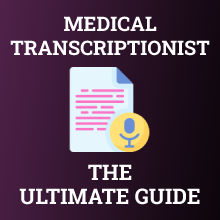Job Description
A medical transcriptionist’s role offers excellent entry-level experience and does not require lengthy school.
Yet, you are collaborating with medical providers to help patients.
Medical transcriptionists require you to listen to a physician or other healthcare provider’s recording and quickly translate the audio to text.
Duties
- Conduct quality improvement audits.
- Edit and review drafts prepared by speech recognition programs to ensure the transcription is consistent in style, complete, and correct.
- Follow legal documentation requirements and patient confidentiality guidelines.
- Follow-up with healthcare professionals to verify accurate reports.
- Identify errors, missing information, and inconsistencies within the report that could jeopardize patient care.
- Input medical reports into electronic health records databases.
- Submit healthcare records to physicians for approval.
- Transcribe and interpret the dictation into operative reports, exam notes, and patient history.
- Translate medical jargon and abbreviations into correct long form.
Salary
The median medical transcriptionist’s U.S. salary is $48,737 as of January 2022.
The pay ranges from $43,412 to $54,327.
In this field, there is a direct correlation between education and salary, so those with lower training (none or certificate programs) will have a starting salary less than those with higher training (associate degree).
Another major factor in determining this salary is the number of years within the industry.
As you progress through your career, raises will be provided based on your performance.
Other salary factors include certifications and other skills that could help boost your career and pay in the medical transcription field.
Annually National Average Salary: $39,090
Average Annual Salary by State
| State | Avg. Annual Salary |
|---|---|
| Alabama | $40,090 |
| Alaska | $42,730 |
| Arizona | $36,480 |
| Arkansas | $33,610 |
| California | $43,610 |
| Colorado | $40,590 |
| Connecticut | $47,480 |
| Delaware | $43,350 |
| District of Columbia | $36,730 |
| Florida | $39,370 |
| Georgia | $31,910 |
| Hawaii | $47,460 |
| Idaho | $36,480 |
| Illinois | $35,890 |
| Indiana | $41,680 |
| Iowa | $41,050 |
| Kansas | $33,710 |
| Kentucky | $36,780 |
| Louisiana | $35,790 |
| Maine | $45,640 |
| Maryland | $40,010 |
| Massachusetts | $44,400 |
| Michigan | $34,790 |
| Minnesota | $50,720 |
| Mississippi | $35,820 |
| Missouri | $34,490 |
| Montana | $42,490 |
| Nebraska | $35,810 |
| Nevada | $40,350 |
| New Hampshire | $38,120 |
| New Jersey | $44,180 |
| New Mexico | $33,500 |
| New York | $40,610 |
| North Carolina | $32,360 |
| North Dakota | $44,020 |
| Ohio | $37,220 |
| Oklahoma | $31,490 |
| Oregon | $43,200 |
| Pennsylvania | $37,720 |
| Rhode Island | $40,630 |
| South Carolina | $36,030 |
| South Dakota | $43,970 |
| Tennessee | $36,990 |
| Texas | $36,270 |
| Utah | $37,590 |
| Virginia | $38,690 |
| Washington | $45,660 |
| West Virginia | $34,940 |
| Wisconsin | $44,710 |
| Wyoming | $49,260 |
| Puerto Rico | $28,070 |
Annual Average Salary: Top 5 States
The top earning state in the field is Minnesota, where the average salary is $50,720.
These are the top 5 earning states in the field:
Conducted by: Bureau of Labor Statistics, Department of Labor.
* Employment conditions in your area may vary.
How to Become a Medical Transcriptionist
Step 1Earn a Degree
The first step for those entering this field is to earn a high school or equivalent degree.
Candidates without this minimum education requirement cannot start the process until it is achieved.
Many pursue an associate’s or bachelor’s degree to improve employment opportunities.
Higher education degrees are offered by various trade schools, tech schools, community colleges, and universities.
Step 2Determine your Typing Speed
The quicker your typing speed, the more money you can earn as a medical transcriptionist.
Although 40 words per minute (WPM) is an acceptable starting point, you should work to increase your typing speed to 80 WPM or more to maximize your earnings.
There are countless typing online typing tests to determine your speed and programs that can help you further develop this skill.
Step 3Acquire a Medical Transcription Certificate
You can find approved medical transcription programs through the Association for Healthcare Documentation Integrity (AHDI).
While a medical transcription certificate is not required, earning this document will give you a competitive edge over candidates without the certificate and expand your knowledge of the field.
Step 4Learn Medical Terminology
Any AHDI-backed certificate program will offer extensive knowledge of medical terminology.
However, the better versed you are in medical terminology, the more valuable and efficient at your job you will become.
In-depth knowledge in this area will help you more quickly and accurately document recordings.
Step 5Earn an RHDS Certification
Two medical transcriber credentials exist.
The first of which is the Registered Healthcare Documentation Specialist (RHDS) certificate, which is earned by new medical transcribers with under two years of field experience.
Training for the exam offers medical terminology and best practices that go beyond theory.
The exam tests knowledge of punctuation, grammar, the English language, and basic comprehension of medical terminology.
Passing the exam gives you a competitive edge over candidates without the certification.
Step 6Gain Work Experience
Successful completion of the RHDS certification helps you find a job and gain experience in the field.
There are countless remote and in-person freelance transcription opportunities available.
While many companies prefer to hire medical transcribers with experience, freelancing is an excellent opportunity to gain that experience, so you can find a full-time position.
Step 7Acquire CHDS Certification
Once you have two years of experience, you can study for the Certified Healthcare Documentation Specialist (CHDS) test, which advances your knowledge of medical terminology and ability to utilize expert reference materials.
Acquiring experience and knowledge from this certificate program can help sharpen your skills and increase your knowledge enough to pass the test with excellence.
Step 8Update your Resume
Once this certification is earned, you have everything necessary to become a medical transcriptionist.
That means the next step is to update your resume with the two AHDI-approved certifications, transcription work experience, and your certificate program.
These qualifications will help you secure a full-time job as a medical transcriptionist.
Step 9Apply for Jobs
With an updated resume, you can apply as an in-house transcriptionist at a physician’s office, or work from home and have many physician office clients.
As a medical transcriptionist, you have the flexibility to work for multiple companies that require different transcription services by continuing your work as a freelancer or owning a service-based company.
Education
With a variety of medical transcription training opportunities, you can graduate in as little as six months and enter the job market almost immediately with your new skills and education or earn an associated degree and start your career in about two years.
There is an education process you must follow to complete whichever training you decide, including:
High School Diploma
To apply for any certificate or degree program, you must have earned a high school or equivalent diploma.
Even if you choose to skip additional educational opportunities and immediately start freelancing, you still must have a high school diploma or no client will hire you, regardless of your typing and accuracy skills.
Determine the Type of Program
The decision on whether to take the six-month program and start working almost immediately after or pursue an associate degree, which is the highest transcription level is a challenging decision for many.
On the one hand, you enter the real world quickly with the six-month program and can start earning immediately.
On the other hand, the associate degree is an actual diploma that will give you considerably more comprehensive details and have you graduating with the most possible knowledge.
Many choose to opt for the six-month program then return to school for their associate’s at night or online while working.
Apply to the Program
Regardless of which option you select, you must apply to the program.
Most are easily accepted into the six-month certificate program, but the associate is an actual diploma, so SAT scores and average high school grades are required.
It is also easier to get financial aid or scholarships for an associate degree than a certificate.
Start the Program
Once you have been accepted into the educational program, you will learn the following basics of the job:
Certificate
Certificate programs are not as detailed as associate degrees, but review the following topics:
- Allied Health
- Confidentiality of health information
- Medical law and ethics
- Medical terminology
- Medical transcription practices
- Using Microsoft Word and Excel
Associate degree
Most associate degree programs cover the following:
Medical terminology about:
- Musculoskeletal system
- Cardiovascular system
- Lymphatic and immune systems
- Respiratory system
- Digestive system
- Urinary system
- Nervous system
- Special senses
- Integumentary system
- Endocrine system
- Reproductive system
- Pharmacology, nuclear medicine, and diagnostic procedures
Medical transcription about:
- The industry
- Confidentiality and legal issues surrounding medical records
- English language basics
- Medical terminology refresher course
- Common medical terms and how to master them
- Pharmacology
- Formatting standards and report types
- Formatting guidelines and transcription rules
- How to prepare transcriptions
In addition to these common topics, most associate degree programs also include a variety of case studies to help you practice the craft.
Graduate
Once you have completed the requirements of the program, you can graduate, update your resume, apply for jobs, and start your new career as a medical transcriptionist.
Video About The Career
Licensing and Certification
To become a medical transcriptionist, there is no licensing requirement, but most employers expect certification when reviewing resumes.
However, if you choose to go the licensing and certification route, you must take and pass the RHDS exam offered by the AHDI then work for two years and take the CHDS exam.
Each multiple-choice test covers the terminology, systems, ethics, and processes required by a medical transcriptionist.
Test takers must also listen to and accurately transcribe portions of an audio clip to pass both exams.
The RHDS certificate is reserved for entry-level medical transcriptionists, while the CHDS certificate was created for more advanced transcriptionists.
All the information in each of these exams is covered in medical transcriptionist educational programs.
Average Training Program Duration: 0-6 Months
Popular Programs
Job Outlook
Although the U.S. Bureau of Labor Statistics projects medical transcriptionist employment opportunities to decline seven percent between 2020 and 2030, the field is projected to add around 6,600 openings every year over the next decade.
These openings are the result of replacing workers who are exiting the labor force or transferring into other fields.
The root cause for this decline is the continued advancement of technology that has changed the way medical transcription is performed.
Speech recognition software has allowed physicians to create many of the same documents, thus reducing transcription requirements, but the technology is not completely accurate yet.
Employment Growth Projection: -7%
2020
2030
That's a higher than average projected growth of -3,900 jobs.
Medical Transcriptionist: Interest Over Time
Should you Become a Medical Transcriptionist
Overall Satisfaction: Medium

CareerExplorer has determined that medical transcriptionists rate their happiness in surveys at 3 out of 5 stars, which makes them in the bottom 32% of career overall satisfaction.
This is not a promising statistic for those looking to enter the job market.
Average Salary: Medium

With an average U.S. salary of around $48,000, this is almost the median per capita average of U.S workers.
The average salary could be higher or lower, based on your education, certifications, experience, and skills.
This is a good salary for those with minimal education and who want to jump into their career.
Job Growth Outlook: Low

The Bureau of Labor Statistics cites that the job growth is expected to decline by 7% between 2020 and 2030 due to the future advancements of speech recognition software and other automated transcribing technologies.
This is a discouraging statistic for those looking to get into medical transcribing in the future.
Education Duration: 0-6 Months

The good news about becoming a medical transcriptionist is that you do not need any education to begin freelancing.
However, it can be difficult to find clients without any education or experience.
The minimum amount of education is only six months, which is refreshing for those who want to jump into their career quickly.
Personal Skills Needed

Employers look for the following skills:
- Ability to multitask
- Accurate typing
- Analytic skills
- Attention to detail
- Diligence
- Fast typing speed
- Focus and concentration
- High computer literacy with the ability to learn new software and technologies
- Knowledge of medical terminology
- Openness to learning
- Problem-solving
- Research skills
- Self-motivation
- The strong handle of the English language including proper syntax, grammar, and punctuation
- Strong listening skills
Frequently Asked Questions
Q. How long do you have to go to school to become a medical transcriptionist?
The length of time to become a medical transcriptionist varies by program.
Most certificates range from 6-12 months from start to completion.
Earning a certificate and finding a job adds a few months so expect to begin working as a medical transcriptionist in as little as 8-12 months.
For those looking to earn an associate degree, expect 18-24 months to complete the program and around two years to start working.
Some associate degree programs offer on-the-job training so you can gain work experience while in school.
Q. How much money does a medical transcriptionist make a year?
The Bureau of Labor Statistics reports that the national median medical transcriptionist hourly wage is around $17.48 per hour, which can vary between states due to cost of living differences.
The Bureau also reports that the lowest ten percent make around $10.50 per hour, while the highest ten percent make $24.90 per hour.
It is important to note that some companies pay by the hour while others pay by the line or are as granular as paying by the word.
Q. What kind of education do you need to be a medical transcriptionist?
Entry-level medical transcription roles first require a high school diploma or equivalent.
Then candidates must acquire postsecondary education like an associate degree or certificate.
During these programs, students study anatomy, healthcare documentation, and medical terminology.
Many programs also offer internships so students can acquire real-world experience working in the field.
Programs with internships are the best option since the hands-on opportunities help students find jobs more quickly since they have some prior experience.
Q. Are medical transcriptionists in high demand?
Yes, the healthcare industry is continuing to grow at a fast rate, thus making the medical transcriptionist role more critical than ever.
As humans will always fall ill, get injured, need consultations, and visit doctors, these consultations and the related paperwork must be recorded for future use.
While technology has greatly advanced, no modern software can replace human intelligence, so medical transcriptionists continue to be in demand for the time being.
Q. What skills do you need to have to be a medical transcriptionist?
There are many skills employers look for in medical transcriptionist candidates including a fast typing speed with pinpoint accuracy, knowledge of medical terminology, and a strong handle of the English language including proper syntax, grammar, and punctuation.
Personal skills a medical transcriptionist should possess include the ability to multitask, high computer literacy with the ability to learn new software and technologies, and strong listening skills.
Also, problem-solving, and analytic skills are required along with focus and concentration, openness to learning, research skills, diligence, self-motivation, and an elevated level of attention to detail.









